Hanbin Zhao
Hierarchical Visual Prompt Learning for Continual Video Instance Segmentation
Aug 12, 2025Abstract:Video instance segmentation (VIS) has gained significant attention for its capability in tracking and segmenting object instances across video frames. However, most of the existing VIS approaches unrealistically assume that the categories of object instances remain fixed over time. Moreover, they experience catastrophic forgetting of old classes when required to continuously learn object instances belonging to new categories. To resolve these challenges, we develop a novel Hierarchical Visual Prompt Learning (HVPL) model that overcomes catastrophic forgetting of previous categories from both frame-level and video-level perspectives. Specifically, to mitigate forgetting at the frame level, we devise a task-specific frame prompt and an orthogonal gradient correction (OGC) module. The OGC module helps the frame prompt encode task-specific global instance information for new classes in each individual frame by projecting its gradients onto the orthogonal feature space of old classes. Furthermore, to address forgetting at the video level, we design a task-specific video prompt and a video context decoder. This decoder first embeds structural inter-class relationships across frames into the frame prompt features, and then propagates task-specific global video contexts from the frame prompt features to the video prompt. Through rigorous comparisons, our HVPL model proves to be more effective than baseline approaches. The code is available at https://github.com/JiahuaDong/HVPL.
Unleashing High-Quality Image Generation in Diffusion Sampling Using Second-Order Levenberg-Marquardt-Langevin
May 30, 2025Abstract:The diffusion models (DMs) have demonstrated the remarkable capability of generating images via learning the noised score function of data distribution. Current DM sampling techniques typically rely on first-order Langevin dynamics at each noise level, with efforts concentrated on refining inter-level denoising strategies. While leveraging additional second-order Hessian geometry to enhance the sampling quality of Langevin is a common practice in Markov chain Monte Carlo (MCMC), the naive attempts to utilize Hessian geometry in high-dimensional DMs lead to quadratic-complexity computational costs, rendering them non-scalable. In this work, we introduce a novel Levenberg-Marquardt-Langevin (LML) method that approximates the diffusion Hessian geometry in a training-free manner, drawing inspiration from the celebrated Levenberg-Marquardt optimization algorithm. Our approach introduces two key innovations: (1) A low-rank approximation of the diffusion Hessian, leveraging the DMs' inherent structure and circumventing explicit quadratic-complexity computations; (2) A damping mechanism to stabilize the approximated Hessian. This LML approximated Hessian geometry enables the diffusion sampling to execute more accurate steps and improve the image generation quality. We further conduct a theoretical analysis to substantiate the approximation error bound of low-rank approximation and the convergence property of the damping mechanism. Extensive experiments across multiple pretrained DMs validate that the LML method significantly improves image generation quality, with negligible computational overhead.
Efficiently Access Diffusion Fisher: Within the Outer Product Span Space
May 29, 2025Abstract:Recent Diffusion models (DMs) advancements have explored incorporating the second-order diffusion Fisher information (DF), defined as the negative Hessian of log density, into various downstream tasks and theoretical analysis. However, current practices typically approximate the diffusion Fisher by applying auto-differentiation to the learned score network. This black-box method, though straightforward, lacks any accuracy guarantee and is time-consuming. In this paper, we show that the diffusion Fisher actually resides within a space spanned by the outer products of score and initial data. Based on the outer-product structure, we develop two efficient approximation algorithms to access the trace and matrix-vector multiplication of DF, respectively. These algorithms bypass the auto-differentiation operations with time-efficient vector-product calculations. Furthermore, we establish the approximation error bounds for the proposed algorithms. Experiments in likelihood evaluation and adjoint optimization demonstrate the superior accuracy and reduced computational cost of our proposed algorithms. Additionally, based on the novel outer-product formulation of DF, we design the first numerical verification experiment for the optimal transport property of the general PF-ODE deduced map.
IAP: Improving Continual Learning of Vision-Language Models via Instance-Aware Prompting
Mar 26, 2025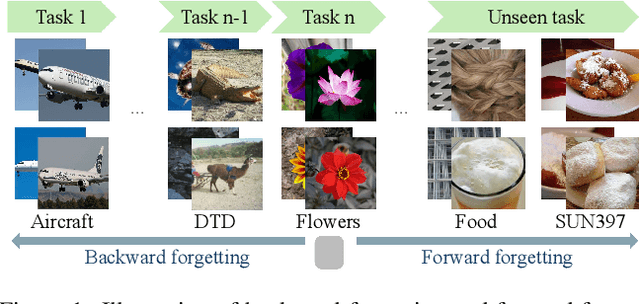
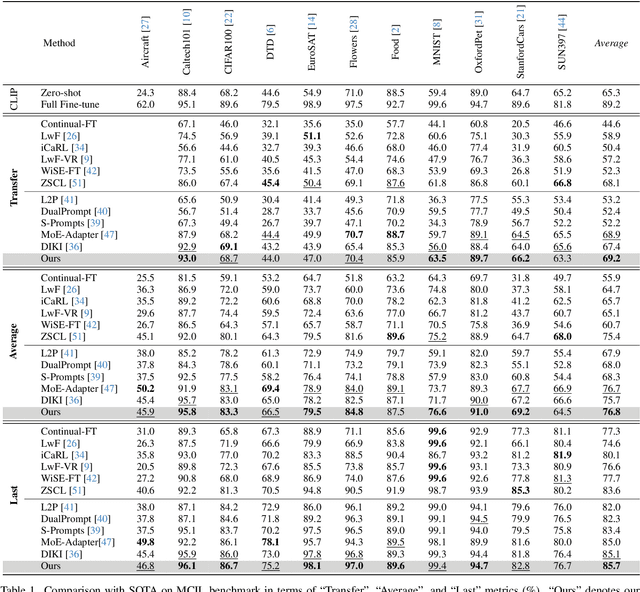


Abstract:Recent pre-trained vision-language models (PT-VLMs) often face a Multi-Domain Class-Incremental Learning (MCIL) scenario in practice, where several classes and domains of multi-modal tasks are incrementally arrived. Without access to previously learned tasks and unseen tasks, memory-constrained MCIL suffers from forward and backward forgetting. To alleviate the above challenges, parameter-efficient fine-tuning techniques (PEFT), such as prompt tuning, are employed to adapt the PT-VLM to the diverse incrementally learned tasks. To achieve effective new task adaptation, existing methods only consider the effect of PEFT strategy selection, but neglect the influence of PEFT parameter setting (e.g., prompting). In this paper, we tackle the challenge of optimizing prompt designs for diverse tasks in MCIL and propose an Instance-Aware Prompting (IAP) framework. Specifically, our Instance-Aware Gated Prompting (IA-GP) module enhances adaptation to new tasks while mitigating forgetting by dynamically assigning prompts across transformer layers at the instance level. Our Instance-Aware Class-Distribution-Driven Prompting (IA-CDDP) improves the task adaptation process by determining an accurate task-label-related confidence score for each instance. Experimental evaluations across 11 datasets, using three performance metrics, demonstrate the effectiveness of our proposed method. Code can be found at https://github.com/FerdinandZJU/IAP.
TAIL: Text-Audio Incremental Learning
Mar 06, 2025Abstract:Many studies combine text and audio to capture multi-modal information but they overlook the model's generalization ability on new datasets. Introducing new datasets may affect the feature space of the original dataset, leading to catastrophic forgetting. Meanwhile, large model parameters can significantly impact training performance. To address these limitations, we introduce a novel task called Text-Audio Incremental Learning (TAIL) task for text-audio retrieval, and propose a new method, PTAT, Prompt Tuning for Audio-Text incremental learning. This method utilizes prompt tuning to optimize the model parameters while incorporating an audio-text similarity and feature distillation module to effectively mitigate catastrophic forgetting. We benchmark our method and previous incremental learning methods on AudioCaps, Clotho, BBC Sound Effects and Audioset datasets, and our method outperforms previous methods significantly, particularly demonstrating stronger resistance to forgetting on older datasets. Compared to the full-parameters Finetune (Sequential) method, our model only requires 2.42\% of its parameters, achieving 4.46\% higher performance.
CE-SDWV: Effective and Efficient Concept Erasure for Text-to-Image Diffusion Models via a Semantic-Driven Word Vocabulary
Jan 26, 2025Abstract:Large-scale text-to-image (T2I) diffusion models have achieved remarkable generative performance about various concepts. With the limitation of privacy and safety in practice, the generative capability concerning NSFW (Not Safe For Work) concepts is undesirable, e.g., producing sexually explicit photos, and licensed images. The concept erasure task for T2I diffusion models has attracted considerable attention and requires an effective and efficient method. To achieve this goal, we propose a CE-SDWV framework, which removes the target concepts (e.g., NSFW concepts) of T2I diffusion models in the text semantic space by only adjusting the text condition tokens and does not need to re-train the original T2I diffusion model's weights. Specifically, our framework first builds a target concept-related word vocabulary to enhance the representation of the target concepts within the text semantic space, and then utilizes an adaptive semantic component suppression strategy to ablate the target concept-related semantic information in the text condition tokens. To further adapt the above text condition tokens to the original image semantic space, we propose an end-to-end gradient-orthogonal token optimization strategy. Extensive experiments on I2P and UnlearnCanvas benchmarks demonstrate the effectiveness and efficiency of our method.
MOS: Model Surgery for Pre-Trained Model-Based Class-Incremental Learning
Dec 12, 2024Abstract:Class-Incremental Learning (CIL) requires models to continually acquire knowledge of new classes without forgetting old ones. Despite Pre-trained Models (PTMs) have shown excellent performance in CIL, catastrophic forgetting still occurs as the model learns new concepts. Existing work seeks to utilize lightweight components to adjust the PTM, while the forgetting phenomenon still comes from {\em parameter and retrieval} levels. Specifically, iterative updates of the model result in parameter drift, while mistakenly retrieving irrelevant modules leads to the mismatch during inference. To this end, we propose MOdel Surgery (MOS) to rescue the model from forgetting previous knowledge. By training task-specific adapters, we continually adjust the PTM to downstream tasks. To mitigate parameter-level forgetting, we present an adapter merging approach to learn task-specific adapters, which aims to bridge the gap between different components while reserve task-specific information. Besides, to address retrieval-level forgetting, we introduce a training-free self-refined adapter retrieval mechanism during inference, which leverages the model's inherent ability for better adapter retrieval. By jointly rectifying the model with those steps, MOS can robustly resist catastrophic forgetting in the learning process. Extensive experiments on seven benchmark datasets validate MOS's state-of-the-art performance. Code is available at: https://github.com/sun-hailong/AAAI25-MOS
BELM: Bidirectional Explicit Linear Multi-step Sampler for Exact Inversion in Diffusion Models
Oct 09, 2024

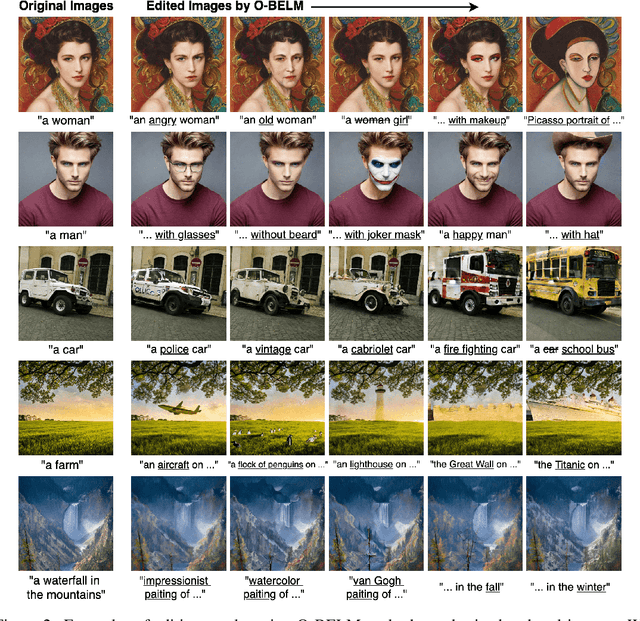

Abstract:The inversion of diffusion model sampling, which aims to find the corresponding initial noise of a sample, plays a critical role in various tasks. Recently, several heuristic exact inversion samplers have been proposed to address the inexact inversion issue in a training-free manner. However, the theoretical properties of these heuristic samplers remain unknown and they often exhibit mediocre sampling quality. In this paper, we introduce a generic formulation, \emph{Bidirectional Explicit Linear Multi-step} (BELM) samplers, of the exact inversion samplers, which includes all previously proposed heuristic exact inversion samplers as special cases. The BELM formulation is derived from the variable-stepsize-variable-formula linear multi-step method via integrating a bidirectional explicit constraint. We highlight this bidirectional explicit constraint is the key of mathematically exact inversion. We systematically investigate the Local Truncation Error (LTE) within the BELM framework and show that the existing heuristic designs of exact inversion samplers yield sub-optimal LTE. Consequently, we propose the Optimal BELM (O-BELM) sampler through the LTE minimization approach. We conduct additional analysis to substantiate the theoretical stability and global convergence property of the proposed optimal sampler. Comprehensive experiments demonstrate our O-BELM sampler establishes the exact inversion property while achieving high-quality sampling. Additional experiments in image editing and image interpolation highlight the extensive potential of applying O-BELM in varying applications.
LW2G: Learning Whether to Grow for Prompt-based Continual Learning
Sep 27, 2024Abstract:Continual Learning (CL) aims to learn in non-stationary scenarios, progressively acquiring and maintaining knowledge from sequential tasks. Recent Prompt-based Continual Learning (PCL) has achieved remarkable performance with Pre-Trained Models (PTMs). These approaches grow a prompt sets pool by adding a new set of prompts when learning each new task (\emph{prompt learning}) and adopt a matching mechanism to select the correct set for each testing sample (\emph{prompt retrieval}). Previous studies focus on the latter stage by improving the matching mechanism to enhance Prompt Retrieval Accuracy (PRA). To promote cross-task knowledge facilitation and form an effective and efficient prompt sets pool, we propose a plug-in module in the former stage to \textbf{Learn Whether to Grow (LW2G)} based on the disparities between tasks. Specifically, a shared set of prompts is utilized when several tasks share certain commonalities, and a new set is added when there are significant differences between the new task and previous tasks. Inspired by Gradient Projection Continual Learning, our LW2G develops a metric called Hinder Forward Capability (HFC) to measure the hindrance imposed on learning new tasks by surgically modifying the original gradient onto the orthogonal complement of the old feature space. With HFC, an automated scheme Dynamic Growing Approach adaptively learns whether to grow with a dynamic threshold. Furthermore, we design a gradient-based constraint to ensure the consistency between the updating prompts and pre-trained knowledge, and a prompts weights reusing strategy to enhance forward transfer. Extensive experiments show the effectiveness of our method. The source codes are available at \url{https://github.com/RAIAN08/LW2G}.
TextToucher: Fine-Grained Text-to-Touch Generation
Sep 09, 2024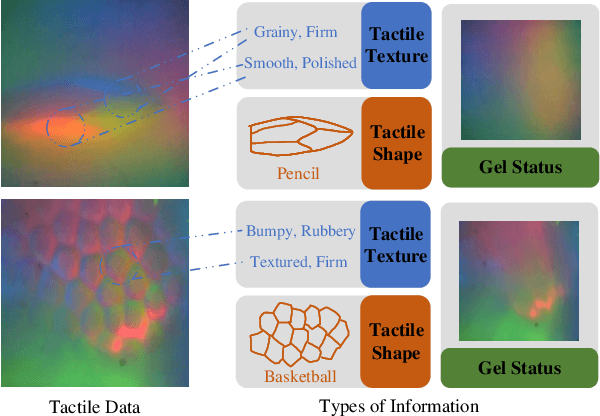

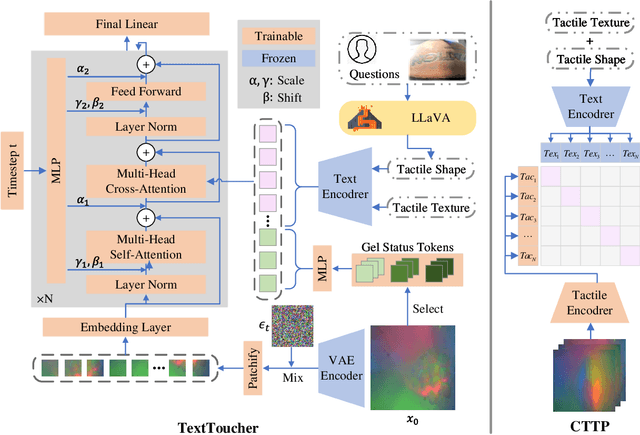

Abstract:Tactile sensation plays a crucial role in the development of multi-modal large models and embodied intelligence. To collect tactile data with minimal cost as possible, a series of studies have attempted to generate tactile images by vision-to-touch image translation. However, compared to text modality, visual modality-driven tactile generation cannot accurately depict human tactile sensation. In this work, we analyze the characteristics of tactile images in detail from two granularities: object-level (tactile texture, tactile shape), and sensor-level (gel status). We model these granularities of information through text descriptions and propose a fine-grained Text-to-Touch generation method (TextToucher) to generate high-quality tactile samples. Specifically, we introduce a multimodal large language model to build the text sentences about object-level tactile information and employ a set of learnable text prompts to represent the sensor-level tactile information. To better guide the tactile generation process with the built text information, we fuse the dual grains of text information and explore various dual-grain text conditioning methods within the diffusion transformer architecture. Furthermore, we propose a Contrastive Text-Touch Pre-training (CTTP) metric to precisely evaluate the quality of text-driven generated tactile data. Extensive experiments demonstrate the superiority of our TextToucher method. The source codes will be available at \url{https://github.com/TtuHamg/TextToucher}.
 Add to Chrome
Add to Chrome Add to Firefox
Add to Firefox Add to Edge
Add to Edge